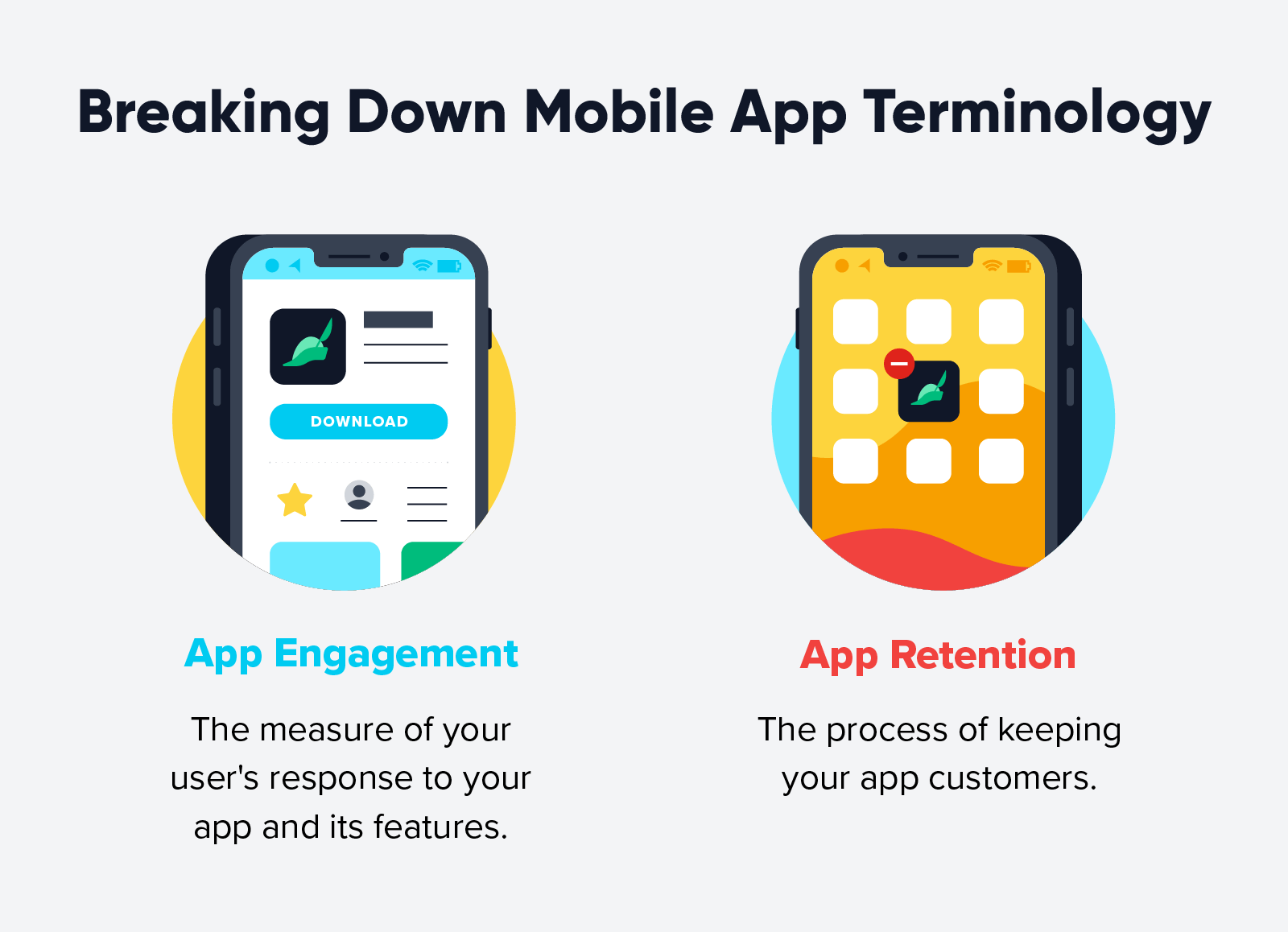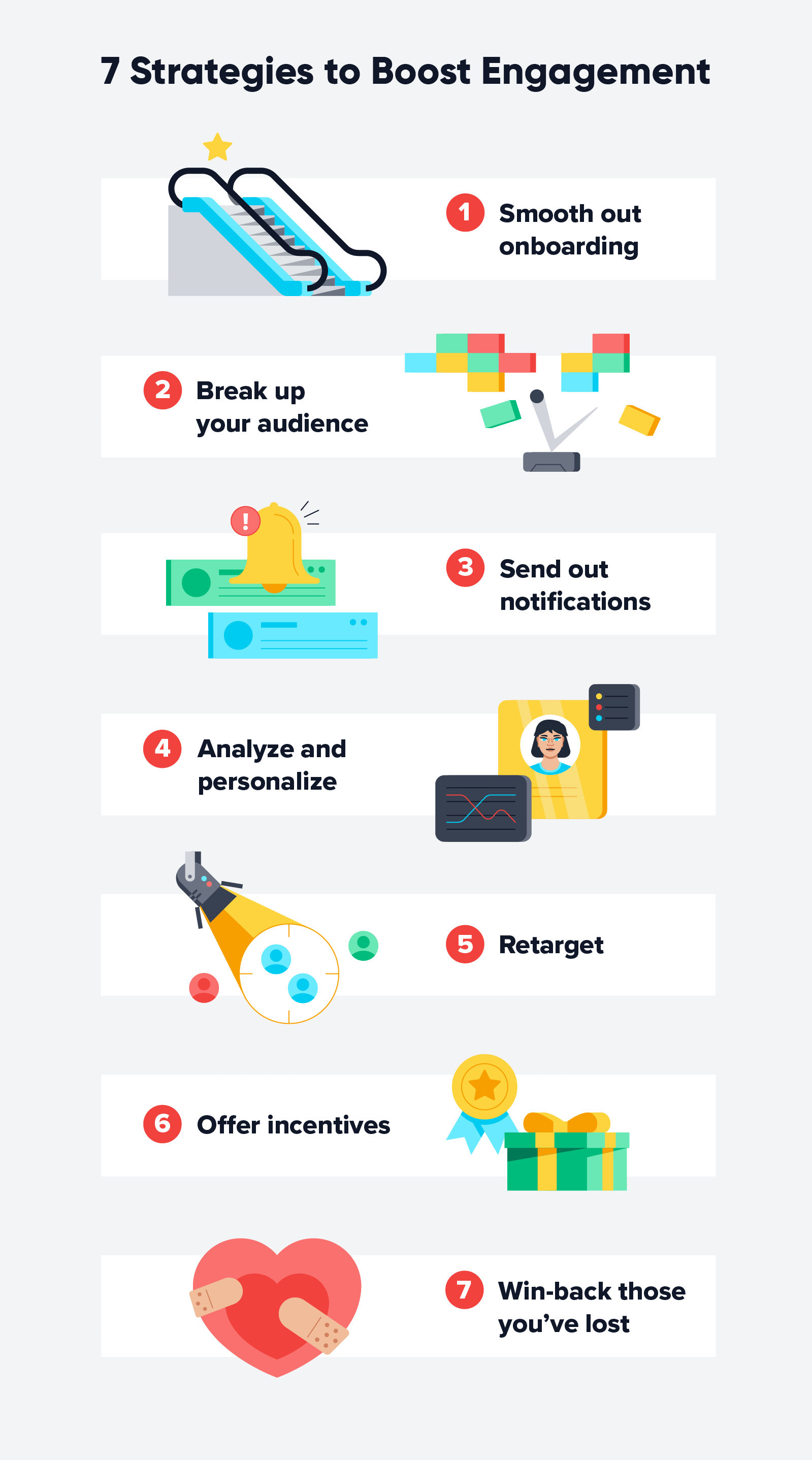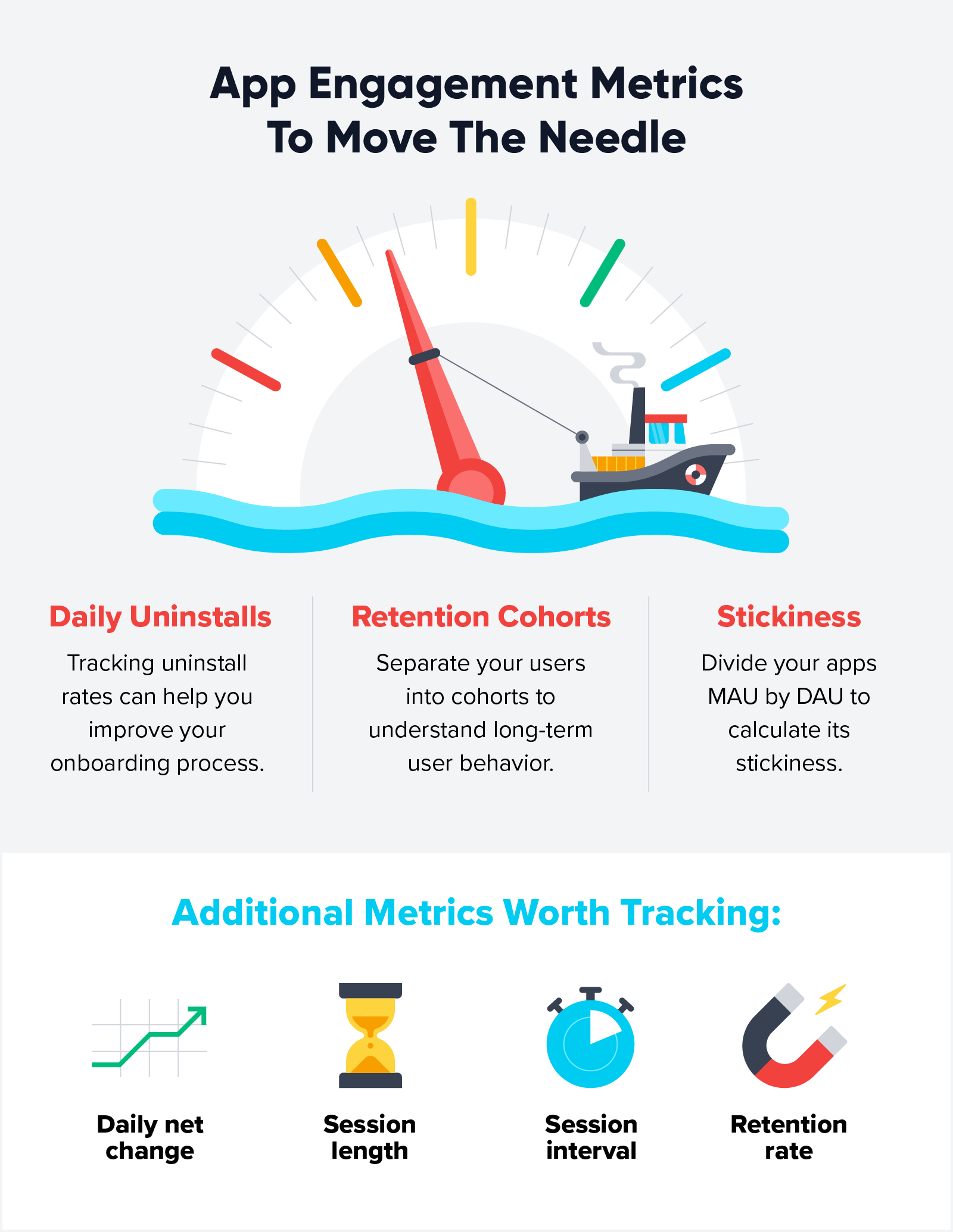Consumers demand excellence. Whether it’s websites or mobile apps, users swiftly abandon experiences that fail to meet their expectations. But even with meticulous development and design efforts, success hinges on effectiveness. This is where data becomes indispensable.
By tracking mobile app engagement, businesses can make informed decisions, seamlessly converting users into loyal customers. With the staggering number of app downloads in 2023 exceeding 256 billion*, the potential for conversions is limitless. In this blog, we’ll discuss strategies to improve mobile app engagement to help you boost user retention and conversions.
What Is Mobile App Engagement?
Mobile app engagement is a measure of your users’ response to your app as a whole or certain features of your app. By collecting metrics surrounding how users interact with your app, you can make smarter marketing decisions.
What Is Mobile App Retention?
Mobile app retention is simply keeping your app users as customers. Mobile app retention rate refers to the number of users that download and continue to use your app over the long term. While every app download is a good start, seeing high rates of user retention means you’re doing something right. After all, that’s the only path toward real growth.
7 Strategies to Increase Mobile App Engagement
Keeping users engaged with your mobile app requires a mix of creativity, strategy, and understanding user behavior. The following seven strategies provide actionable insights to ensure your app not only attracts users but also keeps them coming back for more.
1. Smooth Out Onboarding
First impressions are pivotal, especially with apps where users often decide within minutes whether to stay or leave. If your app is too confusing or doesn’t offer the value promised, users will be quick to bounce. A clunky onboarding process can frustrate users and lead to high drop-off rates.
That’s why smoothing out the onboarding process is so crucial for growth. To create a seamless onboarding experience:
- Simplify Navigation: Ensure the interface is intuitive and guides users effortlessly through key features.
- Personalization Options: Allow users to set preferences or customize their experience right from the start, making the app feel tailored to their needs.
- Show Immediate Value: Highlight your app’s core benefits upfront through interactive tutorials, videos, or quick tips.
- Incentivize Actions: Offer rewards, discounts, or exclusive content to encourage users to complete the onboarding process.
An effective onboarding process doesn’t just improve retention rates; it establishes trust, boosting mobile app engagement. By showing your users why your app is the best and allowing them to change their experience to fit their needs, you can create the ultimate goal for any company: converting users into life-long customers.
2. Segment Your Audience
Treating all your users as a monolith is a recipe for disengagement. Effective audience segmentation allows you to deliver more relevant content and interactions, driving deeper engagement and satisfaction.
Here’s how to segment effectively:
- Behavioral Data: Group users based on actions such as time spent on the app, features they use most, or their purchase history.
- Demographics and Location: Tailor campaigns to specific age groups, regions, or cultural preferences.
- Engagement Levels: Identify power users, occasional users, and inactive users to target them with appropriate messaging.
- Lifecycle Stages: Differentiate between new users, long-term users, and those at risk of churning.
By understanding and addressing the unique needs of each segment, you can craft personalized campaigns that resonate and drive measurable results.
3. Use Push Notifications at the Right Times
Push notifications can be a double-edged sword. Poorly timed or irrelevant messages can irritate users, but thoughtfully crafted notifications can boost engagement and conversions.
Maximize the impact of your push notifications by:
- Timing Wisely: Send notifications during times when users are most likely to engage, such as lunch breaks or after work hours.
- Personalizing Content: Use names, past behaviors, or preferences to make notifications feel personal.
- Highlighting Value: Promote timely deals, exclusive offers, or updates that users genuinely care about.
- Triggering Actions: Remind users to complete abandoned actions like checking out their cart or finishing a level in a game.
When executed correctly, push notifications can re-engage users without crossing the line into being intrusive.
4. Analyze and Personalize
Data is your most powerful asset when it comes to understanding user behavior. Leverage analytics to uncover patterns and craft personalized experiences that keep users coming back.
Steps to analyze and personalize effectively:
- Collect Actionable Data: Track in-app behavior, session duration, feature usage, and churn patterns.
- Identify Key Trends: Use analytics tools to understand what’s working and what isn’t.
- Implement Personalization: Customize app experiences, marketing messages, and content recommendations based on user data.
- A/B Testing: Experiment with different approaches to refine your personalization efforts and optimize results.
Personalization creates a sense of exclusivity and care, making users feel valued and more likely to stay engaged.
5. When All Else Fails, Retarget
Even the best apps lose users, but retargeting gives you a second chance to win them back. By identifying lapsed users and reaching out on other platforms, you can reignite interest and drive re-engagement.
Effective retargeting strategies include:
- Smart Deep Linking: Direct users to specific in-app content or features that address their pain points.
- Social Media Ads: Reconnect with lost users through personalized ads on platforms like Facebook, Instagram, or LinkedIn.
- Email Campaigns: Send tailored emails highlighting new features, updates, or exclusive deals.
Retargeting isn’t just about getting users back; it’s about demonstrating the improvements and value that make your app worth another try.
6. Offer Loyalty Incentives
Loyal customers are the backbone of any successful app, often contributing more revenue and advocacy than new users. In fact, loyal customers spend more than their newer counterparts*. Rewarding their loyalty is key to sustaining engagement.
Implement loyalty incentives such as:
- Membership Programs: Offer exclusive perks, discounts, or content to members.
- Point-Based Rewards: Let users earn points for actions like purchases, referrals, or time spent on the app.
- Gamification: Introduce challenges or achievements that reward continued engagement.
Brands like Starbucks and Sephora have successfully used loyalty programs to create a sense of community and exclusivity, driving both retention and revenue.
7. Develop a Win-Back Strategy
Even with the best strategies, some users will inevitably drift away. A well-crafted win-back strategy can re-engage them and provide valuable insights into how to improve your app.
Key elements of a win-back strategy include:
- Gather Feedback: Reach out to inactive users with surveys or feedback forms to understand why they left and what they’d like to see improved.
- Offer Incentives: Use discounts, free trials, or bonus features to entice users back.
- Rebuild Trust: Address complaints or negative experiences with personalized customer support.
- Highlight Updates: Showcase new features, bug fixes, or improved functionalities that directly address past issues.
Win-back campaigns not only help recover lost users but also signal your commitment to continuous improvement and user satisfaction.
Essential Mobile App Engagement Metrics
Understanding their preferences is key to effectively engaging customers. Mobile app engagement metrics provide valuable data for making informed decisions that resonate with your audience. This deeper insight allows marketers to forge stronger connections, refine strategies with high returns, and enhance user experience, ultimately driving long-term retention. Leveraging this data enables you to cultivate lasting relationships and foster customer loyalty.
But diving into data isn’t everyone’s strong suit. For marketers who thrive on creativity rather than analytics, collecting and deciphering data can feel daunting. To streamline this process, we’ve outlined the key mobile app metrics that your marketing team should focus on below. Once you’ve started tracking all the most important engagement metrics for your app, you may begin to see some negative patterns. You can address and correct those patterns by leveraging on the mobile app engagement strategies outlined above.
Daily Uninstalls
Take a moment to consider how many apps you’ve downloaded and then deleted within the past year. What was wrong with them? How did they not live up to your expectations? From a bad platform to invasive notifications, there are many reasons why users uninstall apps. Churn rate is a growing problem. It’s estimated that 56% of users uninstall apps within seven days of installation.*
We surveyed 2,000 mobile app users in 2021, asking for the main reason they uninstalled mobile apps and found the top 3 reasons are:
- They no longer use the app
- Limited storage space
- Too much advertising
That’s why tracking the number of uninstalls you have on a regular basis is important. Knowing this metric can help you understand where you’re going wrong during the onboarding process, gaining valuable data and, therefore, more users over time.
App Launch to App Launch Retention Cohorts
If you read that header and are immediately confused, don’t panic. Retention cohorts aren’t as complicated as they seem.
App launch to app launch retention cohorts is a phrase that refers to the users that install your app, interact with it, and then keep coming back. By separating your users into cohorts, or groups, you’ll be able to better understand why users stay with your app and how their behavior changes over time.
There are many different ways to group your users that will be valuable to your retention efforts. Some of these options include:
- Daily acquisition
- Behavior types
- Returning users
App Stickiness
Understanding your app’s stickiness, in relation to your retention rate, is a good way to determine what you’re doing right and why users love your app. You can look at daily active users (DAU) vs. monthly active users (MAU) to get a better understanding of how your app is performing over time. However, it’s worth noting that these numbers can change daily, so they shouldn’t be the only metric you look at when determining your app’s health.
Whether you consider an “active user” someone who interacts with your app or provides you with information about themselves, knowing these metrics allows you to determine your app’s overall health. By dividing your app’s MAU by its DAU, you can calculate how “sticky” your app is or how often users return. Comparing this metric over time will help you see how effective your marketing campaigns and other efforts are.
Additional Metrics to Consider
In addition to uninstall rates, retention cohorts, and active users, there are several other mobile app customer engagement metrics you should be tracking.
- Daily Net Change: To determine how your user base has changed each day, try this formula:
The number of new users + number of reactivated users = X
X – the number of churned users = daily net change.
- Session Length: Knowing how long the average user spends on your app can help you determine how successful it is.
If you see your users interacting with a certain portion of your app for a longer period of time than others, consider making that section more easily accessible or sending out a push notification to draw more engagement. - Session Interval: Tracking how much time passes between a user’s first and second session on your app is a great way to tell if your onboarding process is effective.
- Retention Rate: By seeing how many users are still engaging with your app after day one, day seven, and day thirty, you can determine your retention rate and make changes that bump that number up over time.
Conclusion
Customers want a personalized and seamless experience with their favorite apps, and by following these strategies, you can give them what they want and, therefore, get what you want in return: their engagement and their business.

Shivkumar M 
Head Product Launches, Adoption, & Evangelism.Expert in cross channel marketing strategies & platforms.
Free Customer Engagement Guides
Join our newsletter for actionable tips and proven strategies to grow your business and engage your customers.















































